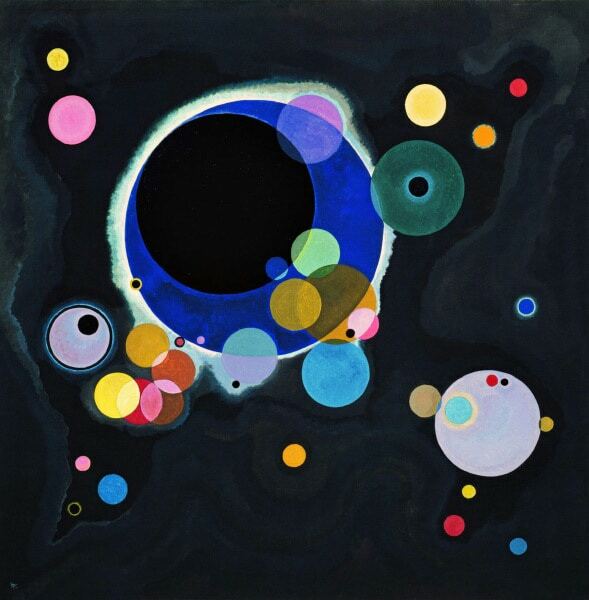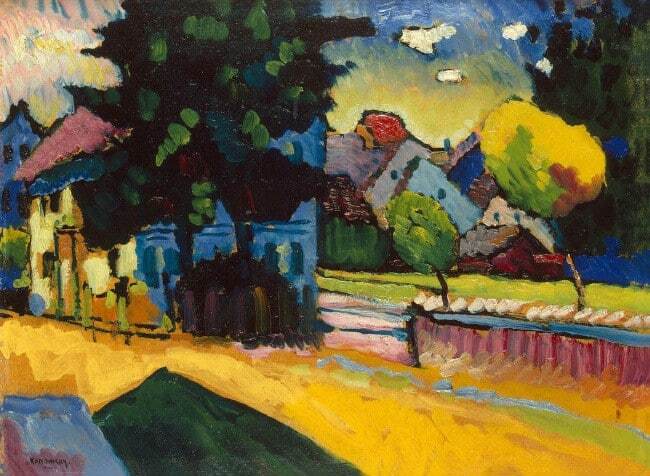Creativity of Vasily Kandinsky is an exact step-by-step reflection of his life's path. All that the artist felt, inner feelings, perception of life realities is reflected in his paintings. From an early age, Kandinsky had the ability to paint, but he became a lawyer and was awarded the title of associate professor with the right to teach. One single event overturns all of his worldview, and he decides to become an artist. The future founder of his own direction in abstractionism, will see the creation of Claude Monet. He decides to create himself, originally draws in the style of impressionism. The most famous paintings of Kandinsky are given below.
10
Gabriel Munter for drawing

"Gabriel Munter for drawing". The post-impressionistic work of the artist is dedicated to his pupil and lover. He drew it from the back, how it works( draws, creates) against the background of the autumn park. Kandinsky wrote very few portraits in his creative life, but depicted his beloved in several of his famous paintings. Münther's face is not visible, but this is not the main thing, attention is drawn to the play of colors and as a figure the artist is clearly different from the surrounding background. Gabriel Munter played one of the main roles in the formation of Kandinsky abstractionist. Even after parting with the artist because of the outbreak of World War I, she retained his work, left by him in Germany in the house of Murnau.
9
Blue rider

"Blue Rider". Quite a small canvas of the artist( compared to other paintings of the author) refers to the early period of Kandinsky's becoming an artist. But some experts already in these works see the preconditions for abstraction, which will become his style much later. Fuzzy outlines, free strokes convey the idea of the author, about the importance of what is depicted, the main thing that the contemplator of the picture feels. This is a peculiar philosophy of the artist to be transferred to his slaves in the style of abstract art. Just like the painting was called the creative association created with Franz Mark. But Kandinsky never linked the name of the association and his famous painting.
8
Composition VII

"Composition VII". Like the earlier canvases of this logical chain, Composition VII is devoted to the theme of the apocalypse. The main theme of the picture is - the Last Judgment, but distinguishes it from Compositions V and VI an abundance of light colors. The picture reflects not oppression, fear and horrors, on the contrary, the release of the soul from material existence into a bright, better world. Judging by the notes, Gabriel Munter she was written in just four days, but the preparatory process, known throughout the world of the canvas, took many months. A lot of sketches and precise plans were made, about 30 sketches, besides many sketches of oil, watercolor, engravings.
7
Several circles of

"Several circles". Creation of this famous canvas falls on the most fruitful period in the work of Kandinsky. This is the culmination of the artist's works with circles in the style of abstract art. In the same year, Kandinsky issues a book of his judgments and thoughts about abstractionism. In the book, he talks about the musical and emotional equivalents of colors. The painting was written in 1926, when the famous "Bauhaus" moved from Weimar to Dessau. Until 1933 until the Nazis came to power, the artist wrote more than 300 watercolors and 160 oil paintings. But the "Bauhaus" was closed and Kandinsky hastily moved to Paris. Many of the works written during this period were destroyed.
6
Moody

"Moody". Childhood and youth Kandinsky were held in Odessa, in the port city. And in many of the artist's works you can trace the theme of the sea. This picture is a clear confirmation of this. At first glance the images on the famous painting are quite understandable. In the center of the boat or ship, you can distinguish between waves, fish, team and flags, but do not forget that this is abstract art. It is worth looking a little differently and this is no longer a marine vessel, and the cosmic and elements are all like cosmic bodies. For someone it looks like a fantastic fish. This picture of Kandinsky is considered a little humorous, playful in relation to the rest of the author's works.
5
Composition VIII

"Composition VIII". Kandinsky was a deeply religious person, and this could not be reflected in the artist's work. As a continuation of the apocalyptic line, the creation of the picture took place at a time when the rational principle, rigor and logic prevailed in the author's works. It was then that he wrote his famous book "Point and line on the plane," describing the psychological significance of each figure in the paintings. The author understood that it would be difficult for an average person to understand the depth of thought, so he recommended not to focus on every detail. The artist advises you to try to convey through yourself the emotions emanating from the picture, to feel the music in forms and lines.
4
Two on horseback

"Two on horseback". One of Kandinsky's early and famous works, at first glance, has nothing to do with his later works and style. But even here one can see the prerequisites in the form of bright spots and lines. Not a clear image of people's faces hints that their emotions are not the main idea. From the picture it breathes peace and tranquility. The direction of the movement indicates that the riders return home, they do not control the horse, it carries them himself. Such hints give wide scope for philosophical reflection. The flowing river also hints at the frailty of life.
3
Color sketch: Squares with concentric circles

"Color sketch: Squares with concentric circles". The famous painting by the artist is a transitional moment in Kandinsky's work from chaos to strict geometry. Some impetus in this was the exhibition of his paintings in 1912, coldly received by critics. However, after the exhibition, Kandinsky's name became known all over the world. In 1913 a "Color Sketch: Squares with concentric circles" was created. The artist begins to study the feedback of viewers about his paintings. He notes which shapes and colors have positive or negative emotions on them, what associations this or that picture causes. Identifies the nuances, not only pleasing to the eye, but also affecting the strings of the soul.
2
The blue sky

"The blue sky". After the forced relocation from Germany to Paris, Kandinsky returns to figure painting again. But it is rather difficult to call it, as it is a mixture with abstract art. Figures, lines and colors give a clear hint of abstraction. Pictures in this period are distinguished by their playful form. The creatures depicted in the famous painting "Blue Sky" make one doubt that this is the sky. Maybe it's the sea with the fish floating in it, squid and jellyfish. The author does not define these creatures, thus leaving room for fantasy. Each viewer will see something closer to him.
1
View of Murnau

"View of Murnau". For a long time Kandinsky lived in Murnau with his beloved Gabriel Munter. Among the artist's works are many famous paintings with landscapes, in which he depicts his house and local nature. Located at the foot of the Alps, the city and the beauty around inspired the artist. In the paintings created during this period of Kandinsky's creative work, deviations from the figured image are already traced, the play of lines and spots comes to the fore. It is in this place that the artist reinterprets his work and thinks more about non-objective art. One day he sees a picture with an amazing play of colors, but in the twilight he does not recognize his picture standing upside down. He understands no matter what is depicted in the picture, most importantly what emotions it causes in the viewer.

